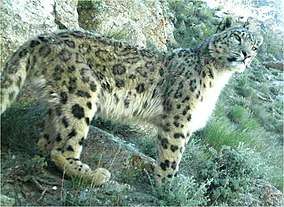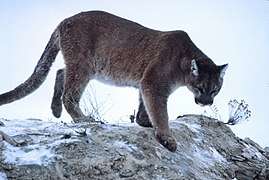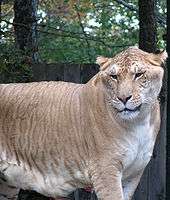Big cat
The term "big cat" is typically used to refer to any of the five living members of the genus Panthera, namely tiger, lion, jaguar, leopard, and snow leopard.[1] Except the snow leopard, these species are able to roar. A more liberal and expansive definition of the term includes species outside of Panthera including the cougar, clouded leopard, Sunda clouded leopard, cheetah and sometimes the several lynx species, although these added species also do not roar.[2]


Despite enormous differences in size, various cat species are quite similar in both structure and behaviour, with the exception of the cheetah, which significantly stands out from the other big and small cats. All cats are carnivores and some are efficient apex predators.[3] Their native ranges include the Americas, Africa, and Asia.
Roaring
The ability to roar comes from an elongated and specially adapted larynx and hyoid apparatus.[4] When air passes through the larynx on the way from the lungs, the cartilage walls of the larynx vibrate, producing sound. The lion's larynx is longest, giving it the most robust roar. The roar in good conditions can be heard 8 or even 10 km away.[5] All five extant members of the genus Panthera contain this elongated hyoid but owing to differences in the larynx the snow leopard cannot roar.
Threats
The principal threats to big cats vary by geographic location, but primarily are habitat destruction and poaching. In Africa many big cats are hunted by pastoralists or government 'problem animal control' officers. Certain protected areas exist that shelter large and exceptionally visible populations of African leopards, lions and cheetahs, such as Botswana's Chobe, Kenya's Masai Mara, and Tanzania's Serengeti. Rather, it is outside these conservation areas where hunting poses the dominant threat to large carnivores.[6]
In the United States, 19 states have banned ownership of big cats and other dangerous exotic animals as pets, and the Captive Wildlife Safety Act bans the interstate sale and transportation of these animals.[7] The initial Captive Wildlife Safety Act (CWSA) was signed into law on December 19, 2003.[8] To address problems associated with the increasing trade in certain big cat species, the CWSA regulations were strengthened by a law passed on September 17, 2007.[9] The big cat species addressed in these regulations are the lion, tiger, leopard, snow leopard, clouded leopard, cheetah, jaguar, cougar, and any hybrid of these species (liger, tigon, etc.). Private ownership is not prohibited, but the law makes it illegal to transport, sell, or purchase such animals in interstate or foreign commerce. Although these regulations seem to provide a strong legal framework for controlling the commerce involving big cats, international organizations such as the World Wildlife Fund (WWF) have encouraged the U.S. to further strengthen these laws. The WWF is concerned that weaknesses in the existing U.S. regulations could be unintentionally helping to fuel the black market for tiger parts.[10]
Conservation
An animal sanctuary provides a refuge for animals to live out their natural lives in a protected environment. Usually these animal sanctuaries are the organizations which provide a home to big cats whose private owners are no longer able or willing to care for their big cats. However, use of the word sanctuary in an organization's name is by itself no guarantee that it is a true animal sanctuary in the sense of a refuge. To be accepted by the United States Fish and Wildlife Service (FWS) as a bona fide animal sanctuary and to be eligible for an exemption from the prohibition of interstate movement of big cats under the Captive Wildlife Safety Act (CWSA), organizations must meet the following criteria:[11]
- Must be a non-profit entity that is tax exempt under section 501(a) of the Internal Revenue Code
- Cannot engage in commercial trade in big cat species, including their offspring, parts, and products made from them
- Cannot breed big cats
- Cannot allow direct contact between big cats and the public at their facilities
- Must keep records of transactions involving covered cats
- Must allow the service to inspect their facilities, records, and animals at reasonable hours
Species
- Family Felidae
- Genus Panthera
- Tiger, Panthera tigris Asia
- Lion, Panthera leo (Sub-Saharan Africa, Gir Forest in India; extinct in former range of southeast Europe, Middle East, much of Asia, and North America)
- Jaguar, Panthera onca (the Americas; from the southern United States to northern Argentina)
- Leopard, Panthera pardus (Asia, Africa and European Russia)[12]
- Snow leopard, Panthera uncia (syn. Uncia uncia - mountains of central and south Asia)
- Genus Acinonyx
- Cheetah, Acinonyx jubatus (Sub-Saharan Africa and Iran; extirpated in much of its former range in Eurasia)
- Genus Puma
- Cougar Puma concolor (North and South America)
- Genus Panthera
Evolution
It is estimated that the ancestors of most big cats split away from the Felinae about 6.37 million years ago.[13] The Felinae, on the other hand, comprises mostly small to medium-sized cats, including the domestic cats, but also some larger cats such as the cougar and cheetah.[14]
A 2010 study published in Molecular Phylogenetics and Evolution has given insight into the exact evolutionary relationships of the big cats.[15] The study reveals that the snow leopard and the tiger are sister species, while the lion, leopard, and jaguar are more closely related to each other. The tiger and snow leopard diverged from the ancestral big cats approximately 3.9 Ma. The tiger then evolved into a unique species towards the end of the Pliocene epoch, approximately 3.2 Ma. The ancestor of the lion, leopard, and jaguar split from other big cats from 4.3–3.8 Ma. Between 3.6–2.5 Ma the jaguar diverged from the ancestor of lions and leopards. Lions and leopards split from one another approximately 2 Ma.[16] The earliest big cat fossil, Panthera blytheae, dating to 4.1−5.95 MA, was discovered in southwest Tibet.[17]
| 3.9 Ma |
| ||||||||||||||||||||||||
Weight range
The range of weights exhibited by the species is large. At the bottom, adult snow leopards usually weigh 22 to 55 kg (49 to 121 lb), with an exceptional specimen reaching 75 kg (165 lb),[18][19] and cheetahs typically weigh 21–72 kg (46–159 lb).[20]
Male and female lions typically weigh 150–249.5 kg (331–550 lb) and 110–182 kg (243–401 lb) respectively,[21][22] and male and female tigers 100–306 kg (220–675 pounds) and 75–167 kg (165–368 lb) respectively.[23] Exceptionally heavy male lions and tigers have been recorded to exceed 306 kg (675 pounds) in the wilderness,[24][25] and weigh around 1,000 pounds (450 kg) in captivity.[24][26]
The liger can grow to be much larger than its parent species, the lion and tiger. In particular, a liger called 'Nook' is reported to have weighed over 550 kg (1,210 lb).[27][28]
Gallery
Species
 Tiger
Tiger Lion
Lion- Jaguar
 Leopard
Leopard Snow leopard
Snow leopard Cougar
Cougar
Hybrids
 Liger
Liger Tigon
Tigon
References
- Davis, B.W., Li, G. and Murphy, W.J. (2010). "Supermatrix and species tree methods resolve phylogenetic relationships within the big cats, Panthera (Carnivora: Felidae)". Molecular Phylogenetics and Evolution. 56 (1): 64−76. doi:10.1016/j.ympev.2010.01.036. PMID 20138224.CS1 maint: uses authors parameter (link)
- "Big Cat Facts". Animal Facts Encyclopedia. Copyright by Jenise Alongi. Retrieved March 17, 2016.
- Balme, G. (2005). Counting Cats Archived 2015-09-13 at the Wayback Machine. Africa Geographic 13: 36−43.
- Weissengruber, GE; G Forstenpointner; G Peters; A Kübber-Heiss; WT Fitch (September 2002). "Hyoid apparatus and pharynx in the lion (Panthera leo), jaguar (Panthera onca), tiger (Panthera tigris), cheetah (Acinonyx jubatus), liger (Panthera leo × Panthera tigris), Tigon (Panthera tigris x Panthera leo) and the domestic cat. (Felis silvestris f. catus)". Journal of Anatomy. 201 (3): 195–209. doi:10.1046/j.1469-7580.2002.00088.x. PMC 1570911. PMID 12363272.
- Kathy Darling (1 January 2000). Lions. Lerner Publications. ISBN 978-1-57505-404-9.
- Hunter, Luke (June 2004). "Carnivores in Crisis: The Big Cats" (PDF). Africa Geographic: 28–41. Archived from the original (PDF) on April 15, 2010.
- Pacelle, Wayne. "Captive Wildlife Safety Act: A Good Start in Banning Exotics as Pets". The Humane Society of the United States. Archived from the original on 19 April 2007. Retrieved 2007-04-01.
- U.S. Fish and Wildlife Service
- Federal Register of the U.S. Congress
- America’s 5,000 Backyard Tigers a Ticking Time Bomb, WWF Says, David Braun, National Geographic, News Watch, October 21, 2010.
- Captive Wildlife Safety Act - What Big Cat Owners Need to Know, U.S. Fish and Wildlife Service, Office of Law Enforcement.
- Khorozyan, I. G., Gennady, F., Baryshnikov, G. F. and Abramov, A. V. (2006). Taxonomic status of the leopard, Panthera pardus (Carnivora, Felidae) in the Caucasus and adjacent areas Archived 3 March 2016 at the Wayback Machine. Russian Journal of Theriology 5 (1): 41–52.
- Joseph Stromberg (2013-11-12). "This Fossil Skull Unearthed in Tibet Is the Oldest Big Cat Ever Found". Smithsonian Institution.
- Wozencraft, W.C. (2005). "Order Carnivora". In Wilson, D.E.; Reeder, D.M (eds.). Mammal Species of the World: A Taxonomic and Geographic Reference (3rd ed.). Johns Hopkins University Press. pp. 532–545. ISBN 978-0-8018-8221-0. OCLC 62265494.
- Davis, Brian W.; Li, Gang & Murphy, William J. (2010). "Supermatrix and species tree methods resolve phylogenetic relationships within the big cats, Panthera (Carnivora: Felidae)". Molecular Phylogenetics and Evolution. 56 (1): 64–76. doi:10.1016/j.ympev.2010.01.036. PMID 20138224.
- "Tiger's ancient ancestry revealed". BBC News. 2010-02-12. Retrieved 2010-04-26.
- Z. Jack Tseng; Xiaoming Wang; Graham J. Slater; Gary T. Takeuchi; Qiang Li; Juan Liu; Guangpu Xie (7 January 2014). "Himalayan fossils of the oldest known pantherine establish ancient origin of big cats". Proceedings of the Royal Society B. 281 (1774): 20132686. doi:10.1098/rspb.2013.2686. PMC 3843846. PMID 24225466.
- Sunquist, M.; Sunquist, F. (2002). "Snow leopard". Wild Cats of the World. Chicago: University of Chicago Press. pp. 377–394. ISBN 978-0-226-77999-7.
- Boitani, L. (1984). Simon & Schuster's Guide to Mammals. Simon & Schuster, Touchstone Books. ISBN 978-0-671-42805-1.
- Estes, R. D. (2004). The Behavior Guide to African Mammals: Including Hoofed Mammals, Carnivores, Primates (4th ed.). Berkeley, USA: University of California Press. pp. 377–383. ISBN 978-0-520-08085-0.
- Nowell, Kristin; Jackson, Peter (1996). Wild Cats: Status Survey and Conservation Action Plan (PDF). Gland, Switzerland: IUCN/SSC Cat Specialist Group. pp. 1–334. ISBN 978-2-8317-0045-8.
- Nowak, Ronald M. (1999). Walker's Mammals of the World. Baltimore: Johns Hopkins University Press. ISBN 978-0-8018-5789-8.
- Mazák, V. (1981). "Panthera tigris" (PDF). Mammalian Species. 152 (152): 1–8. doi:10.2307/3504004. JSTOR 3504004. Archived from the original (PDF) on 9 March 2012.
- Wood, G. L. (1983). The Guinness Book of Animal Facts and Feats. Sterling Publishing. ISBN 978-0-85112-235-9.
- "East African Business Digest", University Press of Africa, with contributions from the Kenya National Chamber of Commerce & Industry, 1963, retrieved 2018-03-18
- "The Nineteenth Century and After". 130. Leonard Scott Publishing Company. 1941. Retrieved 2018-03-17.
- "The Liger - Meet the World's Largest Cat". Liger Facts. Retrieved 2016-07-17.
- "Liger Nook - Liger Profile". Liger World. Retrieved 2018-04-23.
Further reading
- Turner, A. and Antón, M. (1997). The Big Cats and Their Fossil Relatives: An Illustrated Guide to Their Evolution and Natural History. Columbia University Press. ISBN 978-0-231-10228-5.CS1 maint: uses authors parameter (link)
External links

- People Not Poaching: The Communities and IWT Learning Platform